Driven to Work: US Army Humvee driver
#1
US Army Humvee driver
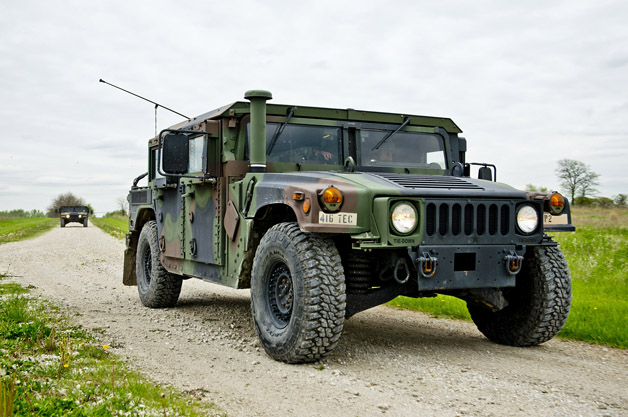
Gallery:
http://www.autoblog.com/photos/us-ar...photo-2632701/
Engine: Turbodiesel 6.5L V8
Power: 190 HP / 380 LB-FT
Transmission: 4-Speed Automatic
Top Speed: 70 MPH
Drivetrain: Four-Wheel Drive
Curb Weight: 7,230+ LBS
Towing: 4,200 LBS
Seating: 2+2
MPG: 10 Combined (est)
Base Price: $160,000 (est)
Power: 190 HP / 380 LB-FT
Transmission: 4-Speed Automatic
Top Speed: 70 MPH
Drivetrain: Four-Wheel Drive
Curb Weight: 7,230+ LBS
Towing: 4,200 LBS
Seating: 2+2
MPG: 10 Combined (est)
Base Price: $160,000 (est)
For the first time in two hours, it was quiet. SPC Brian Stehlin turned the HMMWV ignition switch from Run to Engine Stop, killing the agricultural clatter of the AM General diesel. The four of us, three soldiers in the US Army Reserve and me, pulled up on the combat lock handles inside of each door, freeing us from the thickly lined metal box that passes for an automotive interior. We stepped out, and for just a few seconds the late-morning symphony of insects and birds was the loudest ambient sound. We'd gotten stuck.
Before this, I didn't know that Humvees (the pronounceable common name for High Mobility Multipurpose Wheeled Vehicle, or HMMWV) got stuck. Raised on images, television clips and movies of Humvees racing across deserts and scaling seemingly insurmountable objects, I'd have sooner assumed that the Army's workhorse would charge through a hillside in a torquey blast than bog down before it in the slick Joliet mud.
Of course, neither the quiet nor the mud-entrenchment lasted very long. If I learned one thing during my day of HMMWV driver training with the Reserves' 416th Theater Engineer Command, it's that the Army doesn't lack for ways to get you moving again. Small arms fire from the range down the street crackled, silencing the local fauna just before orders were shouted, chains were pulled from truck beds and the pastoral air was filled once more with grumbling of turbodiesel V8s. Getting stuck turned out to be a lesson in getting free – one of just a few I'd soak up while hanging with the Army.

After contacting the Army's Media Relations Division (MRD) and the Office of the Chief of Public Affairs (OCPA), it was a surprisingly easy journey from my desk in Michigan to the backseat of a student-filled Humvee in Illinois. (It was also the first step in a long and confusing journey of Army acronyms.) My request: Can I learn how soldiers train to drive Humvees? The answer: Yes, come down to the 416th TEC's week-long training session, in and around the westernmost suburbs of Chicago.
To receive a HMMWV M1165A1 (that's the code for the "uparmored" iteration of the Humvee, which I'll explore below) qualification on their operators' permits, around 30 reservist soldiers from the greater Chicago area had come to work. Two days of classroom training, two days of practical training, and one day of written and driving tests were to be completed. Leaving my schoolroom days in the fading past, I agreed to show up on Day 3 of the class; the one that involved gravel course and off-road driving at the Joliet Training Area. The good part, in other words.
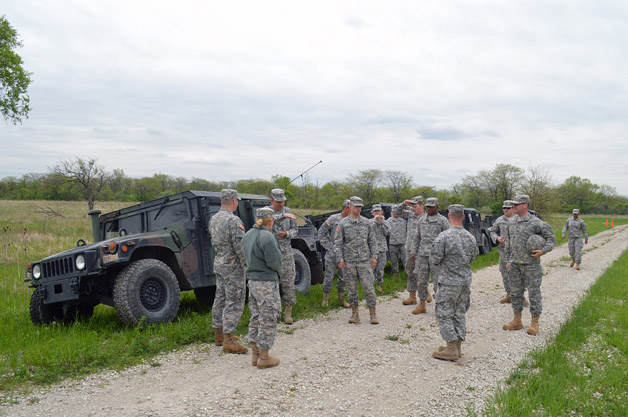
So, by the time I borrowed the "Kevlar" (that means "helmet") of amiable public affairs Sgt. 1st Class Michel Sauret and hopped in the backseat, the class had already covered the basics of the vehicle. Much of that centered on a list called Preventative Maintenance Checks and Services, or PCMS. Detailed in an equipment logbook that is conveniently located inside of each vehicle, PCMS outlines a series of equipment and systems inspections aimed at achieving Fully Mission Capable (FMC) Humvees.
In the case of the 416th's motor pool, most of those Humvees are of the aforementioned uparmored variety. You see, when the HMMWV first shipped to Army bases in the mid-1980s, it came as a replacement for the Jeep – an all-terrain-capable way of moving small groups of soldiers from place to place. So, while it was spec'd by the Army with features like four-wheel drive, 16-inches of ground clearance, brake discs inboard of the wheels (where they're protected by the frame), waterproof electronics, etc., it wasn't intended as an armored front-line fighting vehicle.
However, since the mid-1990s, with scope of use including more urban environment, as well as, infamously, theaters of combat rife with powerful, improvised explosive devices (IEDs), an armor-plated variant of the Humvee was born. This "A" variant of the vehicle adds considerable expense and weight to the platform (more than 700 pounds in basic form, according to AM General), but it also adds critical protection for the soldiers inside.
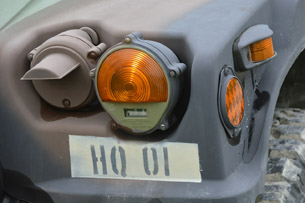
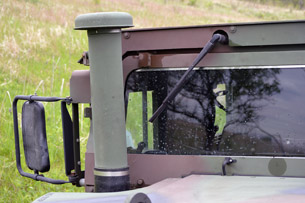
It didn't take long for me to recognize the armor when I mounted up at the 416th motor pool. The uparmored HMMWV looked, in places, as though it was forged in a castle instead of built in a modern factory. Less like another car for use on public roads; more like a tractor that lives in the field and sleeps in the rain.
A solid effort was required just to yank down the door handle to access the cabin, to say nothing of the force needed to shut the thing behind me. SPC Stehlin told me later that each armored door, complete with a sliding window made from inches-thick ballistic glass, weighs upwards of 600 pounds. If you're the type of car shopper that places tangible value on the feeling of a good, solid door-shut, you'd be willing to write a big check for the HMMWV. Closing the hatch behind you sounds like a rifle shot at close range.
In fact, the whole experience of traveling with the Army was imbued with an unholy racket. Before the clattering, belching engine was even fired, the part of my ears not covered in Kevlar were wringing from metallic sounds at every turn. Four-point belts, one over your lap and one over your shoulder, are buckled independently and loudly, while canvas-covered seat frames make a metal-on-metal sigh as one settles in. The Humvee driver/operator is required to check that all doors have been combat locked, meaning large levers at the bottom of each door have been inched downward, locking everything up tight, lest things fly apart when moving fast over broken ground.
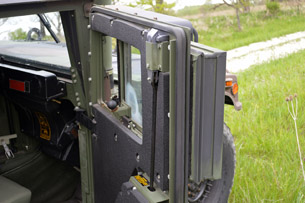
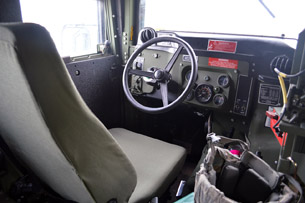
To get to the off-road training grounds in Joliet, our first battle was with some suburban Chicago traffic as we traveled the 30-odd miles from the 416th HQ in Darien, IL. Traveled on the freeway, that is. I asked SPC Stehlin about the accelerative qualities of the Humvee's 6.5-liter diesel V8, which he described as a "low-horsepower, high-torque motor," and received a smile and some unheard response. Try as I might, I couldn't register his answer over the sonic cauldron of tire roar, wind rush, and the high-pitched wail of thousands of steel bolts seemingly willing to give into friction and vibration and burst apart at any given moment. Considering the death-metal levels of NVH in the cabin and the Humvee's optimistic top speed of 70 miles per hour – it's hard work for 190 horsepower and 380 pound-feet of torque to push nearly 8,000 pounds of American steel up to speed – I'd say it's fair to call the HMMWV a "bad" highway cruiser.
Further more, to describe the interior "spartan" would be somewhat disingenuous – there are far too many levers, wires, lights, warning signs, and ominously protruding bits for that to be accurate – but there's clearly not much accommodation made for comfort.
CPT Randolph Belden, who was around when the first HMMWVs started entering the field, did intimate (in a perfect 'You kids have it so good' fashion) that the newest version of the vehicle is far more comfortable than the original recipe. In the back seat, I found just enough room to fit my long legs behind the driver's seat without intrusion into the seatback, and there was more than enough lateral space in the hugely wide vehicle to stow the assembled caps, sweatshirts, backpacks, lunches and other sundry equipment that come with three soldiers and one reporter. There may be a painful lack of cupholders, but in terms of raw volume, the Humvee cabin is mammoth.
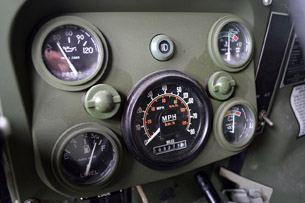
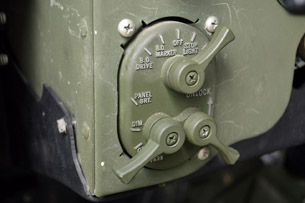
I pointed this out to CPT Belden, who reminded me that, of course, a lot of that space is taken up when the HMMWV is in a combat zone. For starters, soldiers wearing vests and toting rifles are bigger than the unarmored variety I rode with, and the Humvees carry a lot more equipment, too. SPC Stehlin pointed out the empty slots in the communications bank where expanded radio equipment lives, and also noted that there can be full banks of computers forward of the Truck Commander (front passenger) seat, as that position is responsible for all manner of logistics while underway. (Even on our non-combat maneuver, LT Schmitz in the TC spot was asked to maintain comms with the rest of the convoy, and serve as a second set of eyes for moving the low-visibility vehicle through highway traffic.) What's more, there are all manner of weapons systems that could be, but weren't installed on our vehicle, including central turret. Clearly, this is a much busier place to be when driven over hostile ground.
After stopping for fuel and then doing a lap of the gravel track and emergency-stopping box that comprised the first section of the test course, it became clear to me that this part of the training was anything but hostile. Honestly, I'd have been more afraid of the Chicago truck drivers.
SPC Barlow, who rode over from Darien in the back of the truck with me, seemed slightly intimidated with the loose surface and closely growing tree line when we first went round, but even she only needed half a lap of the track to get comfortable. By the time she took us around in earnest, she was nearly hanging the rear wheels off the apex of a turn, at a brisk pace, and only slightly apologetic after accelerating and coming to a well-timed, quick stop in the coned-off area.
Instructor Stehlin quoted this first driving test as being only "medium risk," meaning, I think, that you really have to go out of your way to screw it up. Honestly, anyone that's driven an automatic-transmission pickup truck on a two-track road would be at home here, once schooled with the vagaries of the HMMWV controls. Like I said earlier, this really is basic-level instruction.
The specialist even told me that he intended to have some trainees practice a field removal of the non-trivial wheel – that of 32 wheel lugs – to usefully pass time during inevitable periods of "hurry up and wait." After seeing the Basic Issue Item (BII) toolkit, with its four-way lug wrench and scissor jack, I concluded that this might be what bumped the session up from "low" to "medium" on the Army's risk scale. A guy could have a heart attack...
I asked SPC Stehlin about the second, off-road portion of the training and he assured me that, "oh yeah, it's much higher risk" than the gravel road had been. A recon lap showed ground soft enough that the HMMWV's tires dug six-inch-deep ruts in green grass on the first pass, causing us to get ensnared on the subsequent run. A muddy field doesn't sound that serious, I'm sure, but as I alluded to earlier, the glop was no joke.

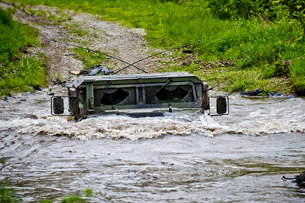
The whole point of this second course was to confront the trainee with adverse traction conditions. It began with the fording of the fast-moving Jackson Creek, perhaps 50-feet wide and 40-inches deep at the crossing. (The Humvees being driven here were equipped with a deep-water fording kit that includes a stovepipe-style snorkel rising above the height of the roof.) From there, it's usually a quick-paced and mud-slinging romp over unimproved sections of field and forest, with a goodly hill to surmount before making the halfway-turn for the staging area.
SPC Stehlin made a full loop when the grass was still intact enough to offer adequate grip to get up the hill, but our second pass in the new ruts proved just too sticky to complete the circuit. By the time we tumbled out of the vehicle in an attempt to get a better read on why we couldn't move forward, the viscous, clay-filled Illinois mud had sealed every grabbing crevice molded into the Goodyear Wrangler tires, making them as smooth as marbles. Not ideal, as you might guess.
These days, HMMWVs in the charge of both the Army Reserves and the National Guard (bodies that, I'm told, are working increasingly in tandem) have domestic missions front of mind. Engineering Companies in particular can be invaluable to have on hand in emergency situations that require clearing debris, restoring serviceable roadways, and safeguarding Americans from natural disasters of all kinds. Everywhere, but especially in the waterlogged Great Lakes and Mississippi border states, that often means dealing with both preparation for, and the aftermath of flooding. In other words, no one in the 416th command was terribly unhappy about the improvised lesson in vehicle "recovery."
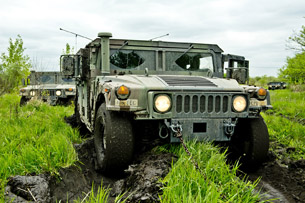
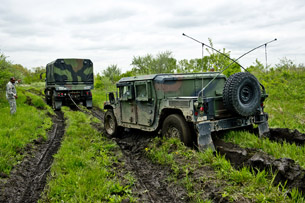
Even with time taken for snapping camera phone photos and generally laughing about how deeply we'd dug ourselves in, it was only a matter of a few minutes before the soldiers on hand had pulled our Humvee free of the sucking mud, with a helping tug from the vehicle behind us. And, as the day progressed and more sticking happened (a lot in fact... that was some vicious field, let me tell ya), larger trucks called Light Medium Tactical Vehicles (LMTV) were driven over to pull harder and on bigger wheels, various tow bars were employed and everyone involved started to get the sense that no mud hole would be deep enough to swallow a motivated Army force. Certainly not a properly outfitted engineering company.
Three decades of tactical dominance by US Military HMMWVs is nearing an end. Even uparmored varieties of the Humvee were replaced in Iraq and Afghanistan by better armored, Mine Resistant Ambush Protected (MRAP) vehicles, as threats of IEDs pushed soldiers more and more in harm's direct way. With MRAPs just a stopgap of sorts, the Army has been working on a HMMWV replacement for quite some time now, one more robust and better-suited to the ever-more-dangerous theaters in which we ask our soldiers to fight. The so-called Joint Light Tactical Vehicle (JLTV) will likely start filtering into service around 2015, marking the end of an era, if not an absolute end of Humvee tenure.
The HMMWV is too ubiquitous, useful and, frankly, affordable (the JLTV is expected to have a base sticker price approximately double that of the Humvee) to kick out of military motor pools en masse. After a day of riding along and listening, I'd say it's too versatile and too easy to operate a tool to lose, as well. Stuck and recovering, armored or in its civvies, the service of the Army's mule is far from complete. I expect Humvee fun in the Joliet muck – drivers' training, I mean – will carry on for a while.
http://www.autoblog.com/2014/05/23/d...-driver-video/
---
Driven to Work: Snowplow Driver
https://www.clublexus.com/forums/car...ow-driver.html
#3
Engine: Turbodiesel 6.5L V8
Power: 190 HP / 380 LB-FT
Transmission: 4-Speed Automatic
Top Speed: 70 MPH
Drivetrain: Four-Wheel Drive
Curb Weight: 7,230+ LBS
Towing: 4,200 LBS
Seating: 2+2
MPG: 10 Combined (est)
Base Price: $160,000 (est)
Power: 190 HP / 380 LB-FT
Transmission: 4-Speed Automatic
Top Speed: 70 MPH
Drivetrain: Four-Wheel Drive
Curb Weight: 7,230+ LBS
Towing: 4,200 LBS
Seating: 2+2
MPG: 10 Combined (est)
Base Price: $160,000 (est)

#4
Lexus Champion
It takes quite a long time for "new technology" to filter down to the military. They are very much concerned about reliability and dependability, and one way they see of guaranteeing that is to go with older, proven technology.
Added to that, with use cycles that may be lighter than equivalent civilian equipment, and constant maintenance, military hardware may last much longer before being replaced than civilian equipment. One good example is aircraft: the military (not only American, but other NATO militaries) are still flying Boeing 707 equivalents, when civilian fleets started retiring them 20+ years ago.
Thread
Thread Starter
Forum
Replies
Last Post






